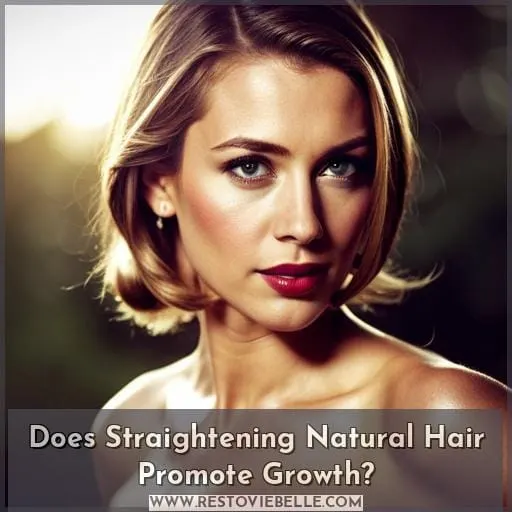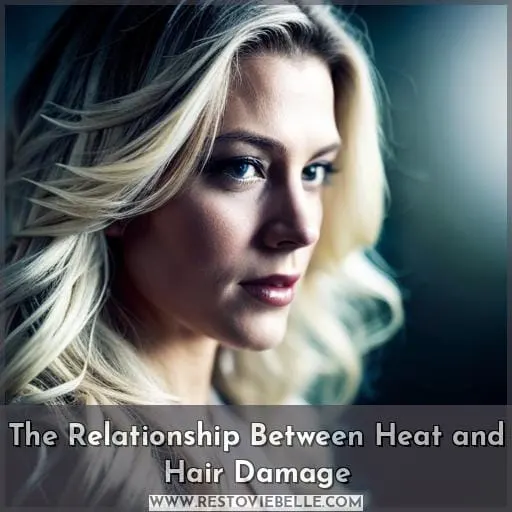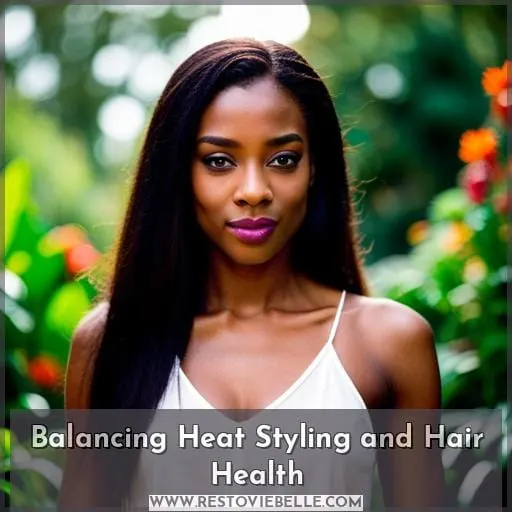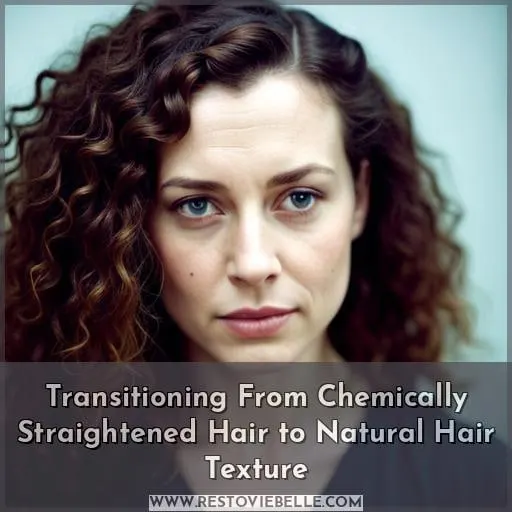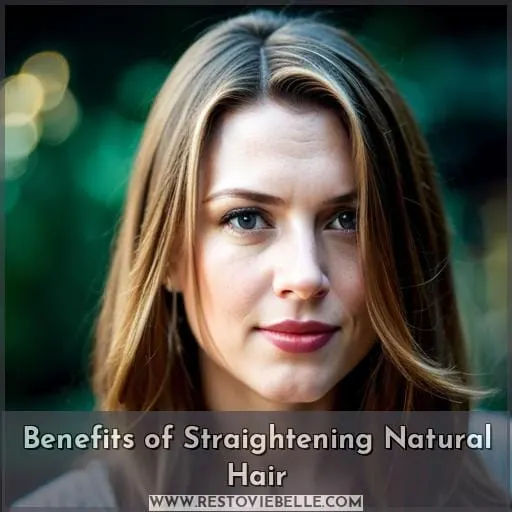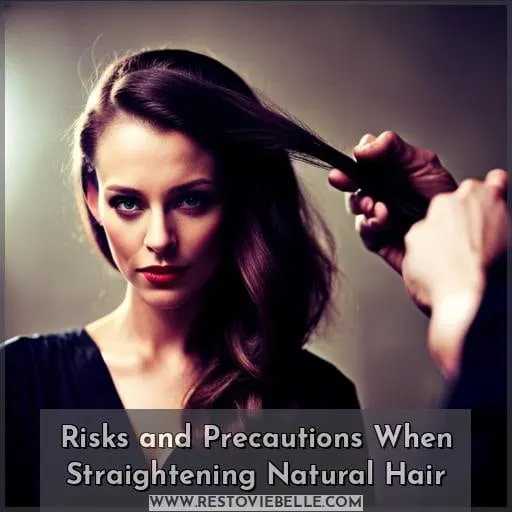This site is supported by our readers. We may earn a commission, at no cost to you, if you purchase through links.
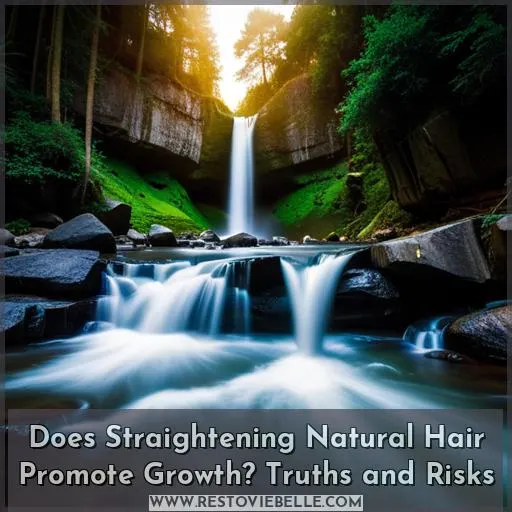 Do you ever wonder if straightening your natural hair could help it grow faster? It can be tempting to think that a flat iron or curling wand might speed up the process, but is there any truth in this idea? Before you invest time and energy into heat styling, it’s important to understand how our hair grows and the potential risks of applying heat.
Do you ever wonder if straightening your natural hair could help it grow faster? It can be tempting to think that a flat iron or curling wand might speed up the process, but is there any truth in this idea? Before you invest time and energy into heat styling, it’s important to understand how our hair grows and the potential risks of applying heat.
This article will explore whether straightening natural hair promotes growth as well as provide tips for ensuring healthy locks.
Table Of Contents
- Key Takeaways
- Does Straightening Natural Hair Promote Growth?
- The Relationship Between Heat and Hair Damage
- Balancing Heat Styling and Hair Health
- Transitioning From Chemically Straightened Hair to Natural Hair Texture
- Benefits of Straightening Natural Hair
- Risks and Precautions When Straightening Natural Hair
- Reader Interactions: Personal Heat Styling Experiences
- Conclusion
Key Takeaways
- The impact of heat styling on hair growth is still a subject of debate.
- Excessive heat styling can lead to breakage and hinder natural hair growth.
- Heat styling can reveal split ends and thinning while detangling curls.
- Balancing heat styling and hair care is crucial for healthy hair growth.
Does Straightening Natural Hair Promote Growth?
Straightening natural hair has been a subject of much debate, with many myths and misconceptions circulating about its effects on growth. To understand the reality of how straightening influences hair’s growth cycle, it is important to consider factors such as heat damage prevention, maintenance routines, and styling products used.
Myth Vs. Reality
With so many myths circulating, it can be hard to know what’s real and what isn’t when it comes to heat styling your tresses – but don’t worry! We’re here to help you uncover the truth about using heat on your hair for ultimate growth.
Heat protectants are essential, as is finding the right appliance with features like ion technology or ceramic/titanium plates. Keeping temperatures low, styling frequency short (once every 6-8 weeks), and curling section by section will all aid in preserving curl pattern while protecting from damage.
Above all else, never overprocess sections of hair; this could lead to irreversible damage that hinders growth.
Understanding Hair Growth Cycle
Unraveling the mysteries of healthy hair growth begins with understanding its natural cycle.
Anagen is the growing phase where new hair is formed.
Catagen is a transitional phase that signals the cessation of hair growth.
Telogen marks resting periods for existing strands.
And exogen involves shedding to make way for new strands.
All these factors influence how often you should trim your ends or use heat styling products on your curls to maintain length and health without causing damage.
Heat doesn’t directly impact hair’s rate of growth but rather causes breakage at high temperatures, which can impede progress towards longer locks if used excessively or improperly over time.
Properly caring for natural texture through proper washing techniques, deep conditioning treatments, moisturizing the scalp regularly, as well as eating a balanced diet, are essential components in achieving desired results when it comes to obtaining maximum length retention while using minimal amounts of heat styling tools throughout one’s journey towards their ultimate goal.
Factors Affecting Hair Growth
Exploring the factors that affect hair growth, you’ll want to consider how heat styling impacts your tresses. Understanding porosity levels can help determine the best way to style and maintain healthy strands.
Heat applications, like straightening natural hair, may provide benefits such as moisture retention, reduced shrinkage, enhanced styling versatility, and scalp exfoliation. However, it’s important to use caution with high temperatures, which could lead to permanent damage and disrupt the normal hair growth cycle.
Regularly using quality appliances at lower settings, combined with consistent maintenance, will keep your mane looking its best while promoting maximum health for optimal length gains!
The Relationship Between Heat and Hair Damage
You may have heard that using heat on natural hair can lead to damage and breakage, hindering its growth. But how much is too much? It is important to understand the effects of excessive heat styling on your hair and scalp in order to find a balance between styling it with care while not compromising its health.
Excessive Heat Styling and Breakage
You should be aware that excessive heat styling can lead to breakage, negatively impacting your natural hair growth. A few tips to prevent this include assessing your hair’s porosity and adjusting your routine accordingly.
Use quality appliances with ion technology and low wattage settings. Apply heat protectants before straightening. Transition over time from chemically treated styles to embrace the texture of natural curls.
Effects of Heat on Hair and Scalp
By using heat to style your hair, you run the risk of damaging it and your scalp. Heat protection is essential for keeping hair healthy and avoiding breakage. Straightening natural hair reduces shrinkage, increasing the appearance of length and volume while also providing styling versatility with minimized split ends.
However, high temperatures can change texture, leading to tangles or dryness. Overprocessing sections multiple times can further damage the hair. Consistent moisturizing treatments, along with a suitable heat protectant, are key components in any successful haircare routine when straightening natural hair.
Balancing Heat Styling and Hair Health
When it comes to heat styling natural hair, proper technique is key. Limiting exposure to heat and using the right products can protect your strands from damage while allowing you to enjoy the benefits of straightening.
Heat protectants should be applied before any use of heated tools, and temperatures should not exceed 375°F (190°C). Additionally, avoid over-processing or running a flat iron more than once through each section.
With these tips in mind, you can have healthy hair with minimal risk of damage due to heat styling.
Limiting Heat Exposure
To keep your hair healthy and beautiful, it’s important to limit heat exposure. Try using heat-free hairstyles like twist outs or braid outs for a change of pace.
Make sure you take care of your natural hair by moisturizing regularly and protecting it with protective styles such as braids, cornrows, twists, etc. Use quality tools when necessary. Ceramic/titanium flat irons are best for minimal damage, while blow dryers should be kept on low settings.
For maximum benefit, go easy on the occasional heat straightening sessions – no more than once every 6-8 weeks.
With these tips in hand, you’ll soon have long-lasting locks that flourish from limiting excess exposure to high temperatures.
Using Heat Protectants
Protect your luscious locks with a quality heat protectant before styling to ensure maximum hair health and growth! Choosing the right one is key: look for spray-in formulas that are designed specifically for natural hair, as well as those formulated to prevent damage caused by straightening.
Heat protectants can help reduce split ends, detangle knots, minimize shrinkage, and keep the scalp healthy. They also increase moisture retention and add shine – all while allowing you to style without fear of damaging your precious curls.
Apply it generously throughout damp or dry strands prior to using flat irons or blow drying on low settings.
With these tips in mind, get ready for healthier locks – and maybe even faster growth too!
Proper Heat Styling Techniques
Mastering the art of heat styling can help you transform your tresses into a luscious, vibrant masterpiece. Proper styling techniques are key to maintaining hair health and avoiding damage. Always use a heat protectant before applying any source of heat, whether it be from blowdrying or flat irons.
When selecting a stylist for treatments like relaxers or keratin services, ask questions about their practices and pay attention to how they handle other clients’ hair during treatments. This can tell you if they prioritize quality care over speediness with results! Also, consider your own natural texture when using heated tools.
Thinner textures will require less intense temperatures than thicker strands for lasting effects without potential breakage over time.
Myths such as ‘straightening makes my hair grow faster’ have been debunked. Take proper precautions for healthy maintenance instead!
Transitioning From Chemically Straightened Hair to Natural Hair Texture
Transitioning from chemically straightened hair to natural texture can be an exciting journey. Embracing your natural curls, while moisturizing and nourishing the scalp, as well as adjusting your hair care routine accordingly, is key for a successful transition.
Embracing Natural Curls
Embrace your natural curls and give them the care they need to thrive! Understanding the unique nature of each curl pattern is essential for finding a successful hair routine.
A moisturizing scalp regimen, hot oil treatments, and proper vitamin intake are just a few ways to nurture healthy curls. Heat protection should also be taken into account; use quality flat irons with ion technology or ceramic/titanium plates on low heat settings at home.
When selecting in-salon stylists, ask about their approach and techniques while observing other clients’ results—avoid high-heat contact blowdrying! Proper understanding of curly hair combined with mindful styling practices can help protect against heat damage while revealing beautiful natural coils.
Moisturizing and Nourishing the Scalp
Rejuvenate your scalp and nourish your hair by moisturizing regularly with natural oils. Scalp care is essential for transitioning from chemically straightened to natural texture, as it helps the hair retain moisture and remain healthy.
To keep heat damage at bay, use a heat protectant before using any hot tools on the hair. Additionally, cut down on frequent styling to reduce breakage that could hinder the growth of healthier locks over time.
When straightening natural hair, remember to avoid high temperatures or too many passes through each section of the strands as this can cause permanent damage that cannot be easily repaired!
Lastly, incorporate vitamins into your routine for improved blood circulation and enhanced quality during transition.
Adjusting Hair Care Routine
As you begin your natural hair journey, don’t forget to adjust your hair care routine according to the unique needs of your curls.
Consider factors like curl preservation, moisture balance, and porosity management when crafting a suitable routine for yourself.
Aim to maintain healthy locks while still achieving desired looks – it’s possible if done right! Be sure to keep an eye on split ends too. They can be minimized with proper scalp treatment and exfoliation but should never go unattended as they’ll worsen over time.
Your natural texture will thrive once you’ve found the perfect balance between protection and style!
Benefits of Straightening Natural Hair
Straightening natural hair can reveal split ends and thinning, while detangling kinks and curls. It also serves as a scalp treatment to deep cleanse the scalp from product buildup, providing gentle exfoliation in the process.
Revealing Split Ends and Thinning
Discover how straightening your hair can reveal split ends and thinness, so you can make sure to keep it healthy. To prevent split ends, reduce the number of chemical treatments. Use a heat protectant before styling and be careful when brushing or combing wet hair.
Additionally, regular scalp treatment will help keep your locks full and lustrous. Styling options such as hot oil treatments or blowouts offer temporary solutions for detangling kinks and curls without causing too much damage.
Finally, employ low heat settings with flat irons along with consistent moisturizing to maintain thickness while keeping any thinning in check.
Detangling Kinks and Curls
Untangling those kinks and curls can be like taking a deep breath of fresh air for your hair. There are many heat-free options to keep your natural hair looking healthy, such as detangling techniques that use tools like wide-toothed combs or fingers.
Taking care when brushing out the knots will help prevent breakage in delicate strands.
By employing these methods on a regular basis, you’ll find yourself with tangle-free locks that look beautiful naturally – without sacrificing their health!
Scalp Treatment and Exfoliation
By straightening your hair, you can unlock a whole new level of scalp treatment and exfoliation. Heat-free styles help promote healthy scalp health, while regularly moisturizing the scalp helps keep it nourished.
Exfoliating benefits from using heat-free styling aids in getting rid of any buildup on the scalp that could be clogging up pores or weighing down strands.
Regularly moisturizing the scalp is also key as it keeps essential oils flowing throughout, which leads to fewer tangles when brushing or combing through natural curls.
Risks and Precautions When Straightening Natural Hair
Straightening natural hair can be an effective styling option, but it also carries potential risks. Heat damage is the biggest concern when straightening natural hair, so choosing a quality heat appliance and finding a skilled stylist are essential for minimizing risk and protecting your locks.
Potential Heat Damage
Be aware that heat styling can be damaging to your hair if not done correctly, so it’s important to take extra precautions when straightening. Heat myths and misconceptions abound, but with proper knowledge of quality tools and techniques, you can prevent damage while still getting the look you want.
Selecting a stylist is key: interview them about their approach and observe how they work on other clients before committing to an appointment.
To ensure your natural curls remain beautiful, use low-temperature settings on ceramic appliances, as well as a protective product prior to styling.
Choosing Quality Heat Appliances
When straightening your hair, choosing quality heat appliances is key for keeping it healthy and avoiding permanent damage. Look for ion technology, wattage, and ceramic or titanium flat irons to provide better protection from heat.
For the best results with natural hair, seek out a skilled stylist who understands styling techniques that won’t cause more harm than good. If you’re not sure of their approach, interview them before entrusting them with your mane! Stick-straight styles require higher temperatures, which can damage delicate curls.
With proper care and using the right techniques plus high-quality tools, you’ll be able to enjoy gorgeous straight hairstyles without sacrificing the health of your luscious locks!
Finding a Skilled Stylist
Finding a skilled stylist is key to ensuring the best possible outcome when straightening your tresses. Interviewing potential candidates and researching their techniques can help you make an informed decision.
Here are three tips for finding a good stylist:
- Check out reviews from previous clients.
- Ask about styling techniques, heat protectants used, and scalp treatments offered.
- Inquire if they use top-quality heat appliances with features such as ion technology or ceramic/titanium plates.
It’s also important to observe how the stylist works with other clients while in the salon. Look for signs of excessive blow-drying or passing through each section more than once with flat irons.
Reader Interactions: Personal Heat Styling Experiences
Share your experiences with heat styling in the comments below to help others understand how they can use heat safely without sacrificing their hair’s health. Straightening natural hair offers a variety of benefits, such as reduced shrinkage, enhanced quality, improved moisture retention, and increased blood circulation.
However, there are risks associated with using too much heat or high temperatures. It is recommended to use quality appliances like ion technology flat irons for safe straightening that won’t damage your hair.
Moderation is key for success when it comes to hair health and achieving growth goals.
While personal experiences will vary based on individual needs and preferences, hearing from fellow readers about their own successes (and failures) can be extremely helpful in navigating the process of finding what works best for you.
Share your journey below, from scalp treatments to tips on avoiding extreme heat settings.
Conclusion
As the sun sets on heat styling your natural hair, it’s worth considering the risks and rewards. To reap the benefits of straightening, while avoiding potential heat damage, it’s essential to understand the relationship between heat and hair health.
With limited heat exposure, proper heat styling techniques, and quality heat tools, you could enjoy the versatility straightening offers without compromising hair growth. However, when it comes to using heat on natural hair, moderation is key. Too much heat can damage your hair and cause breakage, while too little can prevent you from achieving your desired style.
In the end, it’s important to remember that growing healthy hair is a journey, and the path to success is to strike a balance between heat styling and hair care.
